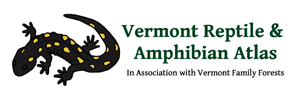The maps on the following pages show the town and status of the reports that we have gathered for all of Vermont’s known species of reptile and amphibian. All records are checked when they are received and given the status of unverified, sight, heard, field, tape, photo, or specimen. A record is considered unverified if not accompanied by written, tape, or photographic documentation, or backed up by a specimen. The most reliable of the unverified records are entered into the database but not mapped. Records given the status of sight, field, or heard are well documented in writing (including scientific literature) but not accompanied by a photo, tape, or specimen. These records are mapped but without a bullet. Those that are accompanied by a photo that shows the field marks clearly, a tape of a breeding call which is clear and repeated, or those that were collected, with a specimen residing at an institution or museum, are mapped with a bullet. Only specimens currently stored in Vermont were checked by the author. Some specimens stored out of state were checked by the staff of the institution if the author thought them to be questionable. We have added a new category to these 2019 maps, which shows towns where a single individual was reported outside of its expected range, and we suspect that it may have been transported by humans (indicated with a T).
Records shown on these maps are separated into historic (greater than 25 years old) and current records. Historic records may be old specimens, literature records, bounty records, or information from the field notes or memories of observers. Historic records do not necessarily imply that the species is now missing from the area. In some cases, it is simply a result of a lack of recent survey effort.
Thousands of records are represented in these maps that were not in our last set of published maps (2013). In addition, previous records are continually reviewed and corrected if needed.
Although information about subspecies is sometimes entered into the database, only one map was made per species, without defining the ranges of the subspecies. The exception to the one map per species rule is the case of the Jefferson and Blue-spotted Salamander complex. These two species have hybridized and created many different hybrid combinations (karyotypes). However, the hybrids are always associated with one of the parent species. When we have specific information about karyotypes for the parent species or their hybrids, they are mapped separately. Hence, there are additional maps for Blue-spotted Salamander Group and Jefferson Salamander Group. If we have no genetic or visually descriptive information that helps to place an individual somewhere on this spectrum, it is mapped on a composite map for both species and their hybrids.

